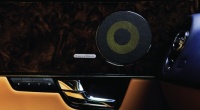Sound-system design on the new Jaguar XJ
A collaboration between car designers and loudspeaker engineers led to an optimum in-car audio experience.


According to Stuart Nevill, a senior applications engineer at Bowers & Wilkins, the speakers in the XJ are of an infinite baffle design. That differs from the earlier XK model which, due to space restrictions, used one ported subwoofer in a sealed enclosure to enhance the bass from the system. In the XJ, Nevill said, the number of subwoofer drivers obviated the need for such a ported design, allowing the company to produce a cleaner sound.
Creation of the bespoke speakers demanded that the Bowers & Wilkins engineering team took into account the form factor of the drivers, especially when designing the speakers for the doors. A compromise had to be met to produce drivers with profiles that would not only fit into the door well at a depth that was both shallow, yet deep enough, to provide the required movement of the voice coil.
Register now to continue reading
Thanks for visiting The Engineer. You’ve now reached your monthly limit of premium content. Register for free to unlock unlimited access to all of our premium content, as well as the latest technology news, industry opinion and special reports.
Benefits of registering
-
In-depth insights and coverage of key emerging trends
-
Unrestricted access to special reports throughout the year
-
Daily technology news delivered straight to your inbox










Water Sector Talent Exodus Could Cripple The Sector
Maybe if things are essential for the running of a country and we want to pay a fair price we should be running these utilities on a not for profit...